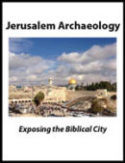
Church of the Holy Sepulchre cropped to approximately the area of the original church.Credit: Gerd Eichmann, CC BY-SA 4.0, via Wikimedia Commons
Most Christian pilgrims to the Holy Land return home with assorted memorabilia, tangible witnesses of their travels. This tradition of Holy Land souvenirs goes back to the earliest known Christian visitors of Jerusalem and other holy places in what is now Israel, Palestine, and Jordan, starting with St. Helena (d. 330), who was believed to have found the True Cross and had a church built there—the Church of the Holy Sepulchre.
In popular imagination, the Middle Ages are famous for the “hunt” for holy relics associated with the body parts of Christian saints. While such practice was widespread, and both royal and church collections did acquire fragments of actual human bodies (authentic or not), most medieval pilgrims gathered less extravagant memorabilia from pilgrimage sites across Europe and the Middle East. Medieval Holy Land travelers—like ordinary modern pilgrims—collected various kinds of natural objects and substances that reminded them of their travels: water, oil, dirt, plants, stones, etc. Such mementos from Holy Land sites, however, were expected to do more than remind someone of their past experience. Known as brandea, the physical Holy Land souvenirs were also meant to communicate holiness and bring blessings through contact with them.
In her article “Sacred Souvenirs: Remembering Holy Land Places,” published in the Winter 2022 issue of Biblical Archaeology Review, Katharine D. Scherff draws attention to this latter type of Holy Land souvenirs. A critical theorist who focuses on medieval visual culture, ritual, and media technology, Scherff explains what kinds of memorabilia medieval pilgrims collected and why. As an example, she introduces a sixth-century wooden reliquary now in the Vatican Museums. It consists of a shallow box and a decorated lid, and is currently on display in the Chapel of St. Peter Martyr, in the Tower of the Vatican Palaces.

We don’t know how or when this reliquary entered the papal collection. One of the most interesting artifacts from the Lateran Treasury, it emerged from the medieval cache in the Sancta Sanctorum, or Holy of Holies—a private papal chapel located at the top of the Scala Santa (Holy Stairs) in the Lateran Palace, by the Archbasilica of Saint John Lateran in Rome. The entrance to the medieval treasury of the Sancta Sanctorum is through a passage under the altar and is protected by an enormous wrought iron cage and a pair of bronze doors covered with reliefs and inscriptions dating from the 13th century. After their inspection in 1902 and 1905, the precious relics were transferred to their current location in the Vatican Museums.

Identified by inscriptions, stones collected from different Holy Land sites were much more than Holy Land souvenirs. Photo in public domain.
Dating from the sixth century, the Sancta Sanctorum reliquary box represents one of the earliest forms of relic collecting associated with Holy Land travels. Its wooden frame contains an assemblage of stones and a wooden sliver set in compacted dirt (see above). Inscribed with place names, these individual objects were presumably collected by a medieval pilgrim from some of the most venerated Holy Land sites, including Bethlehem, the Holy Sepulchre, and the Mount of Olives. The sliding lid of this box is decorated on the exterior with the Golgotha Cross, while the interior surface is painted with scenes from the life of Jesus (see below). Arranged in two registers separated by the central scene of the Crucifixion, these pictures belong to the Christmas cycle (Nativity and Baptism in the Jordan; bottom register) and Easter cycle (Women at the Tomb and the Ascension).

Holy Land souvenirs reminded medieval pilgrims of Holy Land sites and communicated blessings. Photo in public domain.
It may seem counterintuitive that the scenes painted on the lid are not immediately visible. Although they depict some of the most central events for Christian believers, they face the natural materials inside the box rather than the pious viewer. This is because “the Sancta Sanctorum relics and reliquary had an interdependent relationship,” explains Scherff. “Each scene, painted on a field of gold, corresponds to the identifying sites from which these stones were presumably collected,” and is in communication with the material relics inside, “as if each narrative scene were being reenacted over the actual landscape from where the stone was collected.” “Although the stones were directly extracted from holy sites and isolated into a decorative box, they maintained a meaningful relationship with the holy sites, mutually tethered and connected by a space of metaphoric significance.”
To further explore the material blessings of Holy Land souvenirs and the meaningful interplay between Christian imagery and actual artifacts from Holy Land sites, read Katharine D. Scharff’s article “Sacred Souvenirs: Remembering Holy Land Places,” published in the Winter 2022 issue of Biblical Archaeology Review.
Subscribers: Read the full article “Sacred Souvenirs: Remembering Holy Land Places” by Katharine D. Scharff in the Winter 2022 issue of Biblical Archaeology Review.
Read more in Bible History Daily:
“Relics” Associated with John the Baptist Dated to the First Century C.E.
Read more on the BAS Library:
Relics in Rubble: The Temple Mount Sifting Project
Not a BAS Library or All-Access Member yet? Join today.Our website, blog and email newsletter are a crucial part of Biblical Archaeology Society's nonprofit educational mission
This costs substantial money and resources, but we don't charge a cent to you to cover any of those expenses.
If you'd like to help make it possible for us to continue Bible History Daily, BiblicalArchaeology.org, and our email newsletter please donate. Even $5 helps:

The post Holy Land Souvenirs appeared first on Biblical Archaeology Society.

0 Commentaires